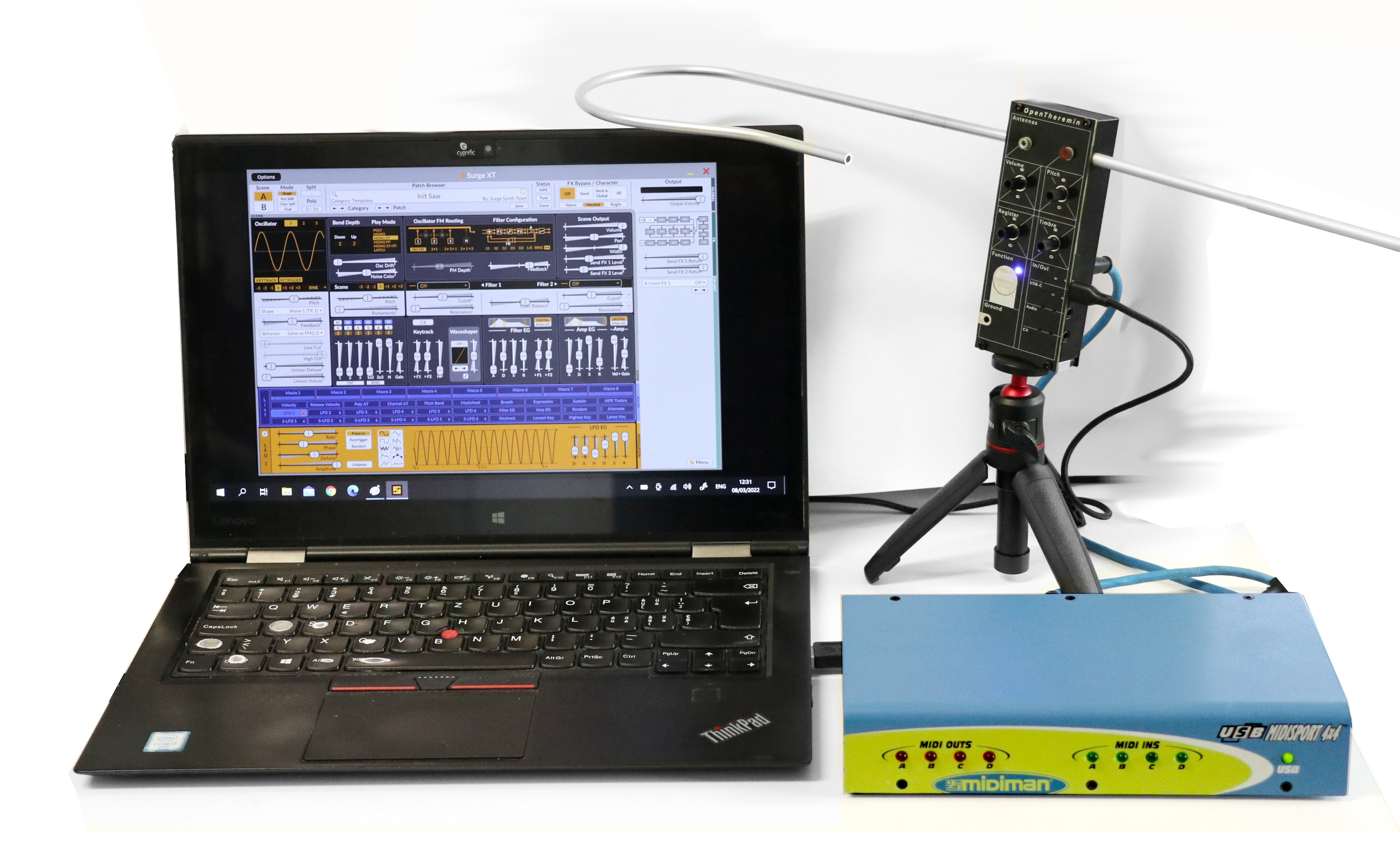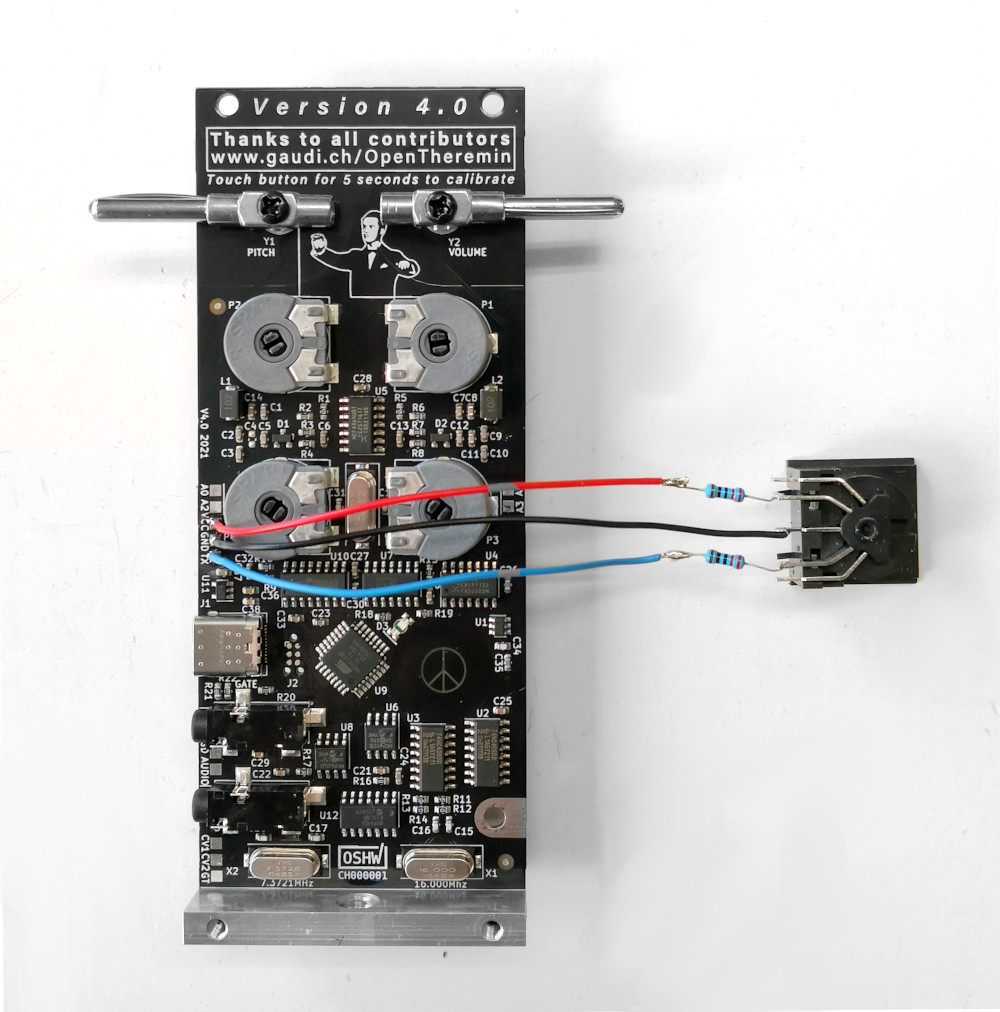OpenTheremin V4 - MIDI
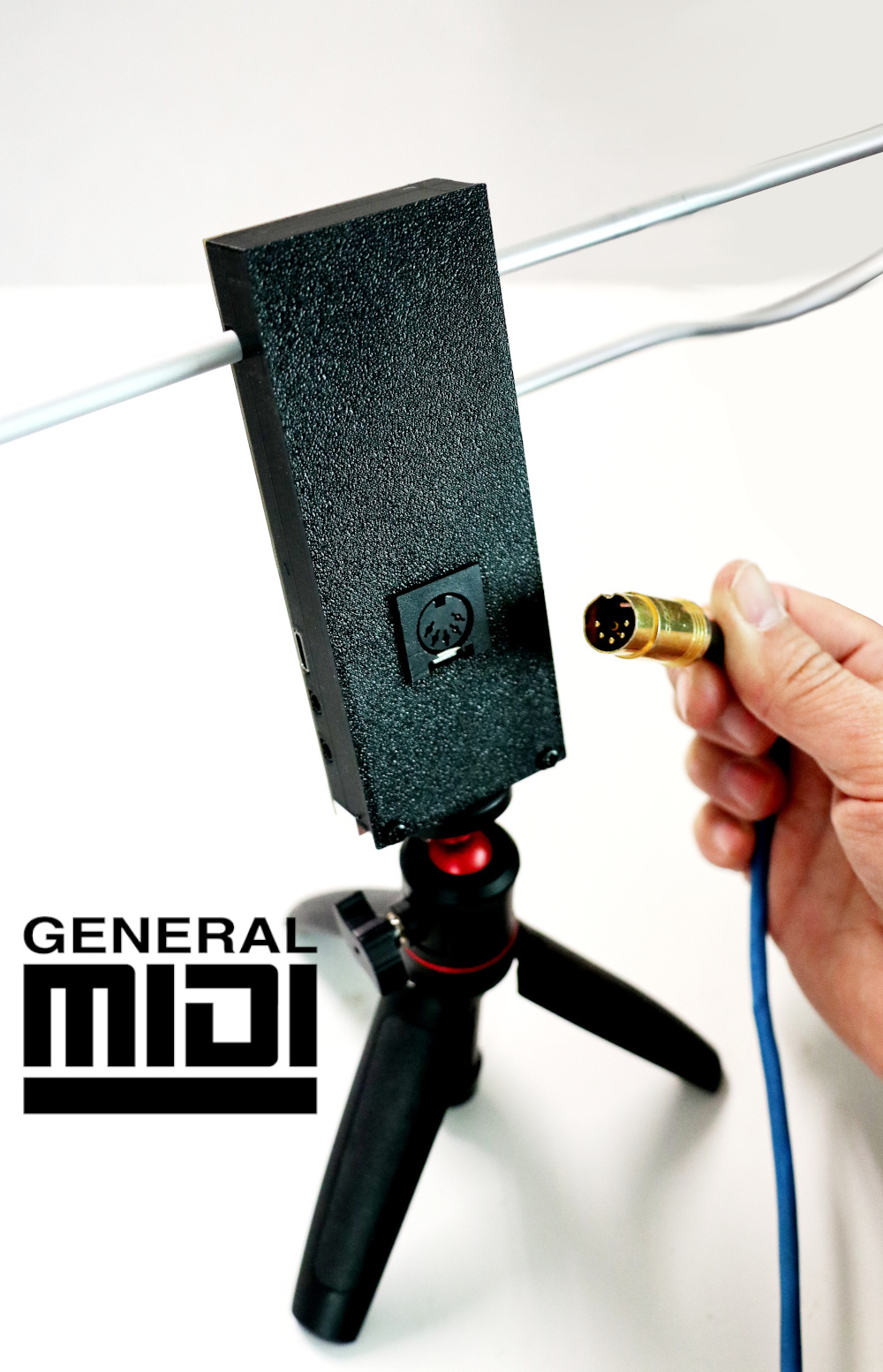
The following MIDI implementation and instructions were developed by Vincent Dhamelincourt and published in a friendly forked GitHub repository. Vincent is an experienced electronics and firmware engineer from Lunel, France and long term member of the OpenTheremin community. *** A great thank you! ***
Why MIDI on a theremin?
To know more what you can do with a MIDI on a theremin see the following document. All the tips here can be applied to Open Theremin.
MIDI-and-Theremin1.0.pdf
Connecting your OpenTheremin V4 to MIDI
There are two possible ways to connect your OpenTheremin via MIDI. You can go through the USB cable to your computer and use a serial to midi router or you can solder a true MIDI connector the OpenTheremin board.
MIDI synthesizer on the computer
To control a MIDI synthesizer on your computer the OpenTheremin with MIDI software is sending MIDI at 115200 baud through USB serial.
Use a serial to MIDI router on your computer such as "hairless-midiserial" (https://projectgus.github.io/hairless-midiserial/) or SM Serial MIDI Converter (https://www.spikenzielabs.com/learn/serial_midi.html) .The router software will then create a MIDI port on your computer that can be used by your software MIDI synthesizer.
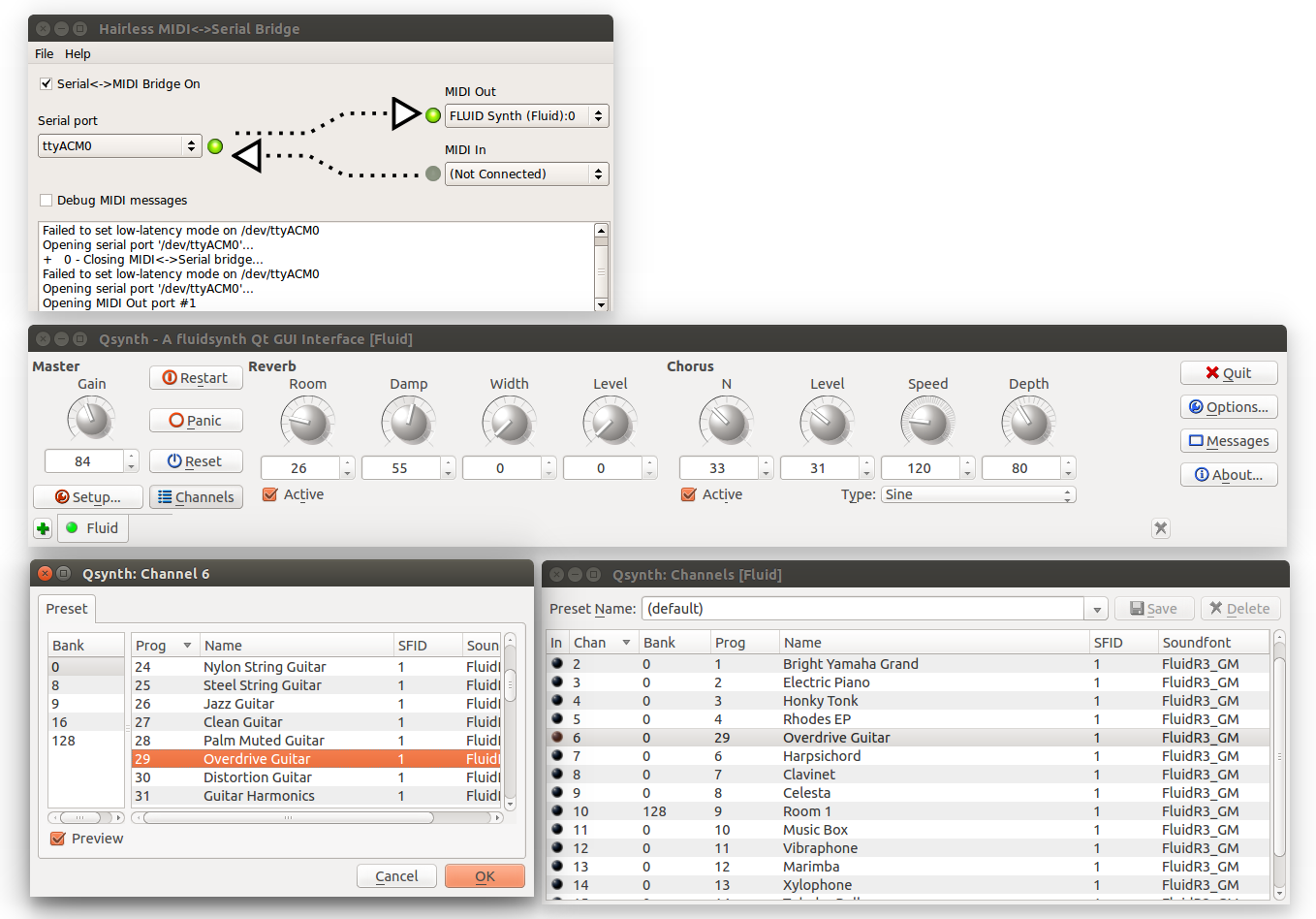
True DIN MIDI interface
You can also use the OpenTheremin MIDI implemented to communicate with a real MIDI device.
With a MIDI port the OpenTheremin can be connected directly to any MIDI compatible synthesizer or to a computer through a USB MIDI interface.
To do so add a female 180° five-pin DIN connector to the pads indicated with VCC, TX and GND. Use 220 Ohm resistors on the pins VCC and TX as shown here:
For the OpenTheremin Version 4.5 with break-out connector use a Flat Ribbon IDC wire cable with 10pins and 1.27mm spacing (link).
The pinout of the cable is as follows. The red wire is wire no 1.
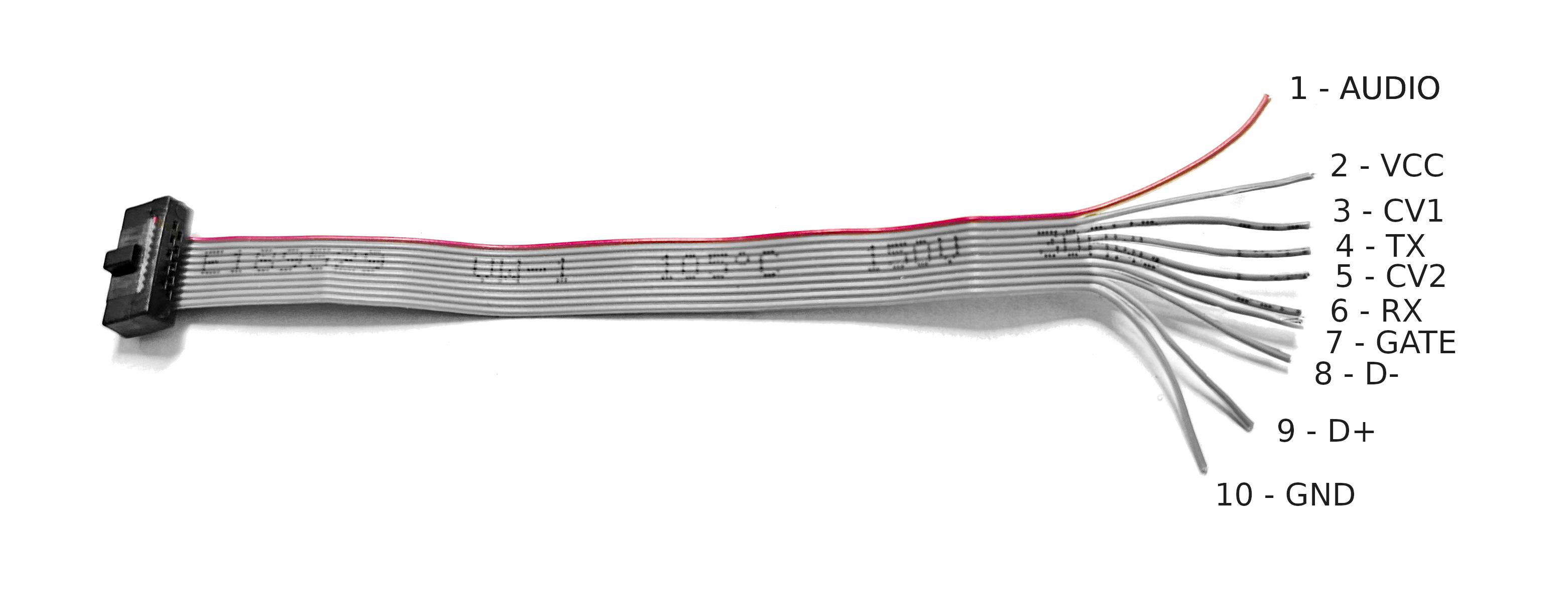
Connect the DIN connector to the wires 2 (VCC), 6 (RX) and 10 (GND) as follows:
![]()
Set the baud rate to 31250 by changing Serial.begin(115200); to Serial.begin(31250); in the code (see instructions below).
With the OpenTheremin being very compact, instead of DIN 5 connector, you might want to use a TRS 2.5 mm (recommanded) or 3.5 mm Jack connector as recently adopted by the MIDI standard: https://www.midi.org/midi-articles/trs-specification-adopted-and-released
Installation:
Download and install the MIDI code for OpenTheremin V4 from the following git repository and carefully read the instruction below. I recommend to first setup and test the theremin as described in the instruction that came with the theremin (using built in sound generator) and then move to MIDI.
To install:
- Download the Theremin MIDI code from https://github.com/MrDham/OpenTheremin_V4_with_MIDI
- Open the File "Open_Theremin_V4.ino" in Software/Open_Theremin_V4/
- In "Application.cpp", take care of selecting MIDI mode that corresponds to your situation (put "//" in front off inadequate line - MIDI through serial is selected by default here):
Serial.begin(115200); // Baudrate for midi to serial. Use a serial to midi router.
//Serial.begin(31250); // Baudrate for real midi. Used with a DIN connector. - Upload to your OpenTheremin as per upload instructions here.
Implementation:
The MIDI open theremin generates NOTE ON/OFF messages and Continuous Controler changes (MIDI CC) depending on settings and hands positions next to antennas.
NOTE ON/OFF:
In MIDI standard NOTE ON/OFF messages have a NOTE NUMBER and a VELOCITY.
Let's consider a Fade-in / Pitch Variation / Fade-out sequence (I use right handed convention):
- Fade-In
When left hand moves away from VOLUME ANTENNA (LOOP) and volume crosses a settable threshold (Volume trigger), a NOTE ON is generated. VELOCITY depends on how fast left hand is moving. Right hand's position next to PITCH ANTENNA (ROD) determines the starting NOTE NUMBER. - Pitch variation
When right hand moves next to PITCH ANTENNA (ROD), PITCH BEND messages are generated (if activated) to reach exact pitch as long as pitch bend range will do. Beyond, a new NOTE ON followed by a NOTE OFF for the previous note are generated if legato mode is activated. Pitch bend range can be configured (1, 2, 4, 5, 7, 12, 24, 48 Semitones) to align with synth's maximum capabilities. - Fade-Out
When left hand moves close to VOLUME ANTENNA (LOOP) and volume goes under Volume trigger threshold, a NOTE OFF is generated to mute the playing note.
MIDI Continuous Controllers (MIDI CCs):
It is possible to assign independent MIDI CCs to the PITCH ANTENNA (ROD) and to the VOLUME ANTENNA (LOOP).
Configuration:
There is two calibration mode. Best use a speaker connected to the theremin to verify calibration and timbre variation.
Normal calibration of antennas: press button for 5 seconds -> Runs normal calibration of antennas (LED blinks until finished). Audio processing from antennas to output jack, including volume and pitch pots, LEDs and button functions, is exactly the same as in open theremin V4. You can play the Audio and the MIDI side by side.
MIDI configuration:
REGISTER pot becomes "SELECT PARAMETER"
TIMBRE pot becomes "PARAMETER VALUE"
To change the settings, select a Parameter from the list below and move "Parameter's Value" to change corresponding setting.
While you rotate the pots, the LED toggles (OFF/PINK) every steps to give you some angular feedback before going back to PLAY/MUTE Status.
- Register: 4 positions as in original Open Theremin V3
- Timbre: 8 positions as in original Open Theremin V3
- Channel: 16 positions (channel 1 to 16)
- Rod antenna mode: 4 positions (Legato off/Pitch Bend off, Legato off/Pitch Bend on, Legato on/Pitch Bend off, Legato on/Pitch Bend on)
- Pitch bend range: 5 positions (1, 2, 4, 5, 7, 12, 24, 48 Semitones). For classical glissando and in order to have same note on audio and MIDI, use exactly same pitch bend range on your synth. Maximum setting possible is recomended.
- Volume trigger / Velocity sensitivity (how fast moves the volume loop's hand): 128 positions (0 to 127)
- Rod antenna MIDI CC: 8 positions (None, 8-Balance, 10-Pan, 16-MSB/48-LSB-GeneralPurpose-1, 17-MSB/49-LSB-GeneralPurpose-2, 18-GeneralPurpose-3, 19-GeneralPurpose-4, 74-cutoff)
- Loop antenna MIDI CC: 8 positions (1-Modulation, 7-Volume, 11-Expression, 71-Resonnance, 74-Cutoff, 91-Reverb, 93-Chorus, 95-Phaser)
Default configuration is: Register = Lowest Register, Timbre = 1st Waveform, Channel = MIDI Channel 1, Rod antenna mode = Legato on/Pitch Bend on, Pitch bend range = 2 Semitones, Volume trigger = 0, Rod antenna MIDI CC = None, Loop antenna MIDI CC = 7-Volume.
MUTE BUTTON:
Sends ALL NOTE OFF on selected channel and stay in mute until it is pushed again.
AUDIO:
Audio processing from antennas to output jack, including volume and pitch pots, LEDs and button functions, is exactly the same as in open theremin V4. You can play the Audio and control MIDI devices side by side.
CV GATE:
CV GATE processing from antennas to output jack is exactly the same as in open theremin V4. You can control your analog devices and MIDI devices side by side.
CALIBRATION:
This device runs normal calibration of antennas after pushing button for a few second as per initial project
Results:
As long as you are inside pitch bend range you can play with the same linearity as with device's sound (same pitch is audible on stable notes without vibrato).
On 24 semitones wide pitch bend range capable monophonic SW synth (tested with Gforce's Minimonsta), the effect is rather good: We play on 4 octaves just like a normal theremin.
12 semitones capable synth are also good but sometime note transition can be heard.
SEE VIDEO:
HINTS and NOTES:
What can I do to get a theremin like glissando?
Activate picth bend and set pitch bend range of the theremin with a high value (12 semitones or 24 semitones). Set pitch bend range of the synth with the same value.
If I do not trigger with the volume hand it also seems to trigger a new tone with the pitch antenna. Guess this is how MIDI works.
When legato mode is activated, if you trigger a note (with volume loop) and go in one direction (with pitch antenna) a new note will be triggered at the limit of pitch bend range.
Legato mode is used as a workaround for a limitation of MIDI (max 24 semitones pitch bend). Maybe some synth can perform pitch bend on more that 2 octaves but none of mine does...
Tweakable parameters (in application.cpp):
Changing this to your taste may require some test and trial.
"#define VELOCITY_SENS 9" -> How easy it is to reach highest velocity (127). Something betwen 5 and 12.
"#define PLAYER_ACCURACY 0.2" -> Pitch accuracy of player. Tolerance on note center for changing notes when playing legato. From 0 (very accurate players) to 0.5 (may generate note toggling).
Possible Human Machine Interface (HMI)
The picture at https://github.com/MrDham/OpenTheremin_V3_with_MIDI/blob/master/MIDI%20Open%20Theremin%20V3%20HMI.bmp gives an example of possible HMI: on "Value" pot, red lines have 4 positions, grey lines have 5 positions and yellow lines have 8 positions. On "Parameter" pot you see coloured lines indicating which colour to follow for the "Value" pot.
Percussive Sounds
The volume trigger can be configured so as we have some volume at note attack on percussive sounds. The volume trigger setting is also used to set sensitivity for velocity (how fast left hand is moving when note is triggered). Volume trigger = 127 (Maximum) won't generate any NOTE ON. It can be used to generate MIDI CC only.
Manipulation of MIDI CCs
Manipulation of "Rod antenna MIDI CC" and "Loop antenna MIDI CC" is not error proof. MIDI newbies should be advised to change their value in MUTE mode.
Added and removed compare to Open Theremin V4.
Serial communication implemented for program monitoring purpose was removed (Particularly during calibration). If you need to monitor calibration for antenna problem fixing, please use original master branch.
Serial port is used to send MIDI messages now.
Support request about MIDI can be directed directly to Vincent here.
LICENSE:
Original project written by Urs Gaudenz, GaudiLabs, 2022 GNU license. This Project inherits this 2022 GNU License. Check LICENSE file for more information All text above must be included in any redistribution




